

The Four Faces of Mass Customization. Virtually all executives today recognize the need to provide outstanding service to customers.

Focusing on the customer, however, is both an imperative and a potential curse. In their desire to become customer driven, many companies have resorted to inventing new programs and procedures to meet every customer’s request. But as customers and their needs grow increasingly diverse, such an approach has become a surefire way to add unnecessary cost and complexity to operations. Companies throughout the world have embraced mass customization in an attempt to avoid those pitfalls and provide unique value to their customers in an efficient manner.
Readily available information technology and flexible work processes permit them to customize goods or services for individual customers in high volumes and at a relatively low cost. Six must dos for successful luxury goods marketing. In luxury brand management, most industry players have realised that experiences are essential.
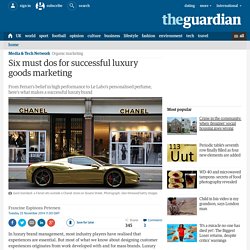
But most of what we know about designing customer experiences originates from work developed with and for mass brands. Luxury brands are an entirely different proposition and require a very specific approach to brand management and marketing. Based on extensive research of the market in collaboration with Pernod Ricard, here are six things luxury brands need to focus on in order to design and market a true luxury experience. Differentiating “True” from “Affordable” Luxury: An Interview with Mickey Ateyeh. Today I’m chatting with my dear friend, Michele (Mickey) Ateyeh, whose career in fine jewelry and designer accessories has taken her from Tiffany & Co. to Hermes, then Angela Cummings, Inc. followed by Karl Lagerfeld and Carlos Falchi designer handbags.

Currently she is directing the newly formed partnership of fine jewelry designer Angela Cummings and Assael. Orit: Where are you right now? 5 signs that customer co-creation is a trend to watch. Updated Editor’s note: This story is part of our Microsoft-sponsored series on cutting-edge innovation.
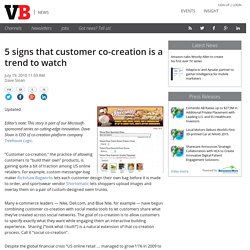
Dave Sloan is CEO of co-creation platform company Treehouse Logic. “Customer co-creation,” the practice of allowing customers to “build their own” products, is gaining quite a bit of traction among US online retailers. For example, custom messenger-bag maker Rickshaw Bagworks lets each customer design their own bag before it is made to order, and sportswear vendor Shortomatic lets shoppers upload images and overlay them on a pair of custom-designed swim trunks. Many e-commerce leaders — Nike, Dell.com, and Blue Nile, for example — have begun combining customer co-creation with social media tools to let customers share what they’ve created across social networks. Collaboration Becomes Key To Success For Retailers And Suppliers. “The need for collaboration — on a micro and macro scale — is greater than ever,” noted Mark Baum, SVP of Industry Relations and Chief Collaboration Officer at Food Marketing Institute.
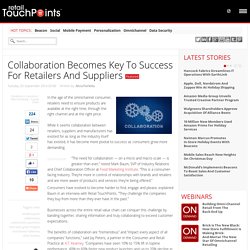
“This is a consumer-facing industry. They’re more in control of relationships with brands and retailers and are more aware of products and services they’re being offered.” Making your marque: The rise of bespoke fashion - Viva Magazine. The trend for customisation and bespoke touches is gathering pace.
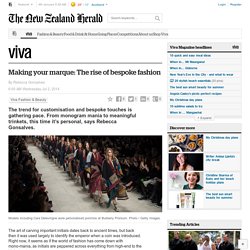
From monogram mania to meaningful trinkets, this time it’s personal, says Rebecca Gonsalves. The art of carving important initials dates back to ancient times, but back then it was used largely to identify the emperor when a coin was introduced. Right now, it seems as if the world of fashion has come down with mono-mania, as initials are peppered across everything from high-end to the high street. Fashion and identity are becoming more closely linked than ever before.
Strategies To Engage The Evolved Consumer. By Rick Chavie, VP, Marketing Retail and Hospitality Solutions, NCR Years ago, the relationship between the shopper and shopkeeper was dramatically different.
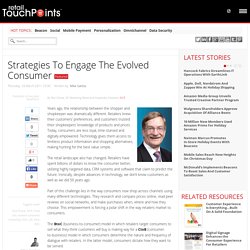
Retailers knew their customers’ preferences, and customers trusted their shopkeepers’ knowledge of products and prices. Today, consumers are less loyal, time-starved and digitally empowered. Technology gives them access to limitless product information and shopping alternatives, making hunting for the best value simple. Collaboration Becomes Key To Success For Retailers And Suppliers. Trends 2015: Marion Debruyne. BESPOKE - The Present and Future for CUSTOMISED TIMEPIECES. Keith W.
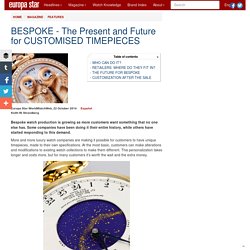
Strandberg Bespoke watch production is growing as more customers want something that no one else has. Some companies have been doing it their entire history, while others have started responding to this demand. More and more luxury watch companies are making it possible for customers to have unique timepieces, made to their own specifications. At the most basic, customers can make alterations and modifications to existing watch collections to make them different. Co-creation. By Chris Nurko and Tom Adams Our organizational branding practice has been busy over the last 18 months, particularly for global and international firms interested in defining their purpose and how this connects to employees, customers and the wider world.

As part of our ongoing interest in the drivers of corporate success and differentiation, we have gathered some insights from our practice leads around the world into the principles successful companies put into action. This is set in the context of a major piece of global research we have just undertaken to understand perceptions of PwC’s global top 100 companies by market capitalisation. The FutureBrand Index set out to test the hypothesis that we need to move beyond pure financial measures of organizational success.
And companies and their stakeholders might benefit from developing a broader definition of ‘value’ in the 21st century. Getting personal: how much further can the trend go? One of the consequences of the digital world that we have all come to embrace is the level of personalisation it affords us.

From websites remembering our purchasing history to the serving of ads that reflect our browsing, our expectations have been raised. In this consumer-centric environment, there is a growing assumption that such tailoring to the individual should be possible in most walks of life, but how easy is it for this degree of personalisation to be achieved in the physical, rather than virtual, world?
Part 2: The Market for Mass Customization Today. As NetNatives become consumers and buyers are "trained" by personalized offerings, the market is finally ripe for mass customization. In part two of this special series focusing on mass customization, Professors Frank Piller and Dominik Walcher take a closer look at what the current market has to offer and provide their conclusions after observing 500 leaders in the field from a customer perspective.
In a recent report for Forrester, J.P. – Mass customization and beyond. Co-creating value with customers and users: Mass customization and beyond by Frank T. Piller and Dennis Hilgers. The Four Faces of Mass Customization. Making it personal: Rules for success in product customization - Bain Brief. The opportunity appears to be significant: A Bain survey of more than 1,000 online shoppers found that while less than 10% have tried customization options, 25% to 30% are interested in doing so. While it is hard to gauge the overall potential of customization, if 25% of online sales of footwear were customized, that would equate to a market of $2 billion per year. Beyond the pure size of the opportunity, our survey showed that those customers who had customized a product online engaged more with the company. They visited its website more frequently, stayed on the page longer and were more loyal to the brand (see Figure 1).
Having It Their Way: The Big Opportunity In Personalized Products. Mass Personalization Is Coming. Are We Ready For It? The modern world can be a dehumanizing place. Long gone is the sweet little old lady at the drugstore counter, replaced by big box retailers, brand logos and barcodes. We’re more often“handled” than serviced, calculated, rather than cared for. That’s about to change in a big way. The brands that are moving from mass production to mass personalisation.
This January, Adobe announced that they were bringing 3D printing capabilities via an update to Photoshop Creative Cloud. This update enables designers to move from 2D to 3D through one simple tool and to easily create ready-to-print files for 3D printing. Whilst many designers might not have much experience in 3D printing, this tool also provides the opportunity for them to quickly produce prototypes without the need for specialised machinery.
It’s early days but it will be exciting to see how designers make use of this new tool and the creations that come out of it. Tech companies are also starting to involve consumers in designing and printing their own creations. In early 2013 Nokia gave Lumia 820 owners the opportunity to customise and 3D print their own phone cases. The demand for a personalised retail experience (Infographic) Burberry personalising new collection with embedded digital content. John Lewis trials interactive sofa studio using RFID and 3D printing.